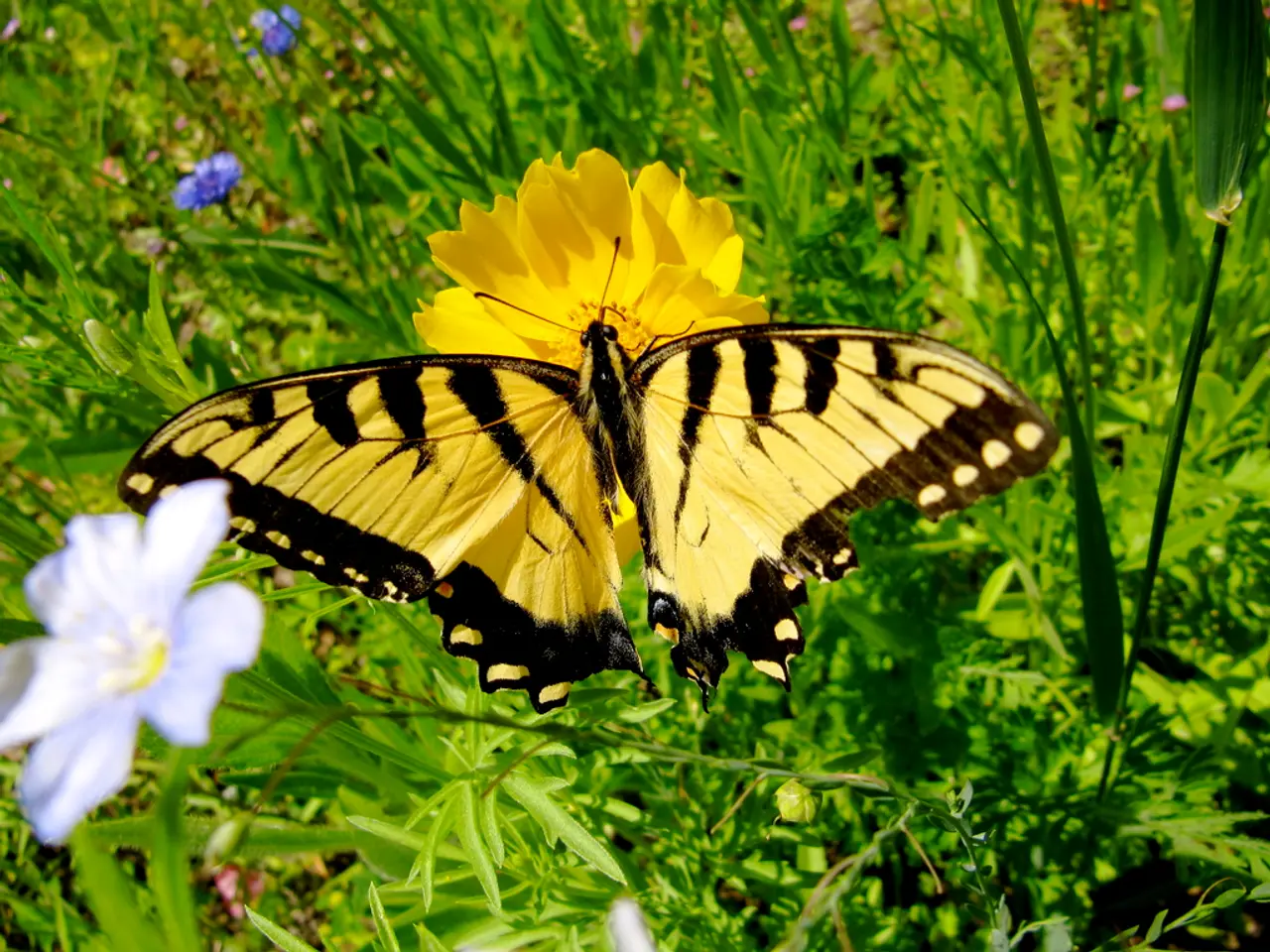Rare, Blue-Hued Tarantulas, Along with Companions, Unveiled in South America's Wilderness
In the heart of Guyana's Kaieteur National Park and Upper Potaro River region, a team of researchers, as part of a joint venture between the World Wildlife Fund (WWF) and Global Wildlife Conservation's Biodiversity Survey Team, made an extraordinary discovery - a previously unknown tarantula species with vibrant blue leg iridescence [1].
This undescribed fossorial species, distinguished by its striking blue coloration on the ventral surface of the patella (leg segment), is a fascinating addition to the diverse tarantula population of Guyana [2]. Although the exact scientific name is yet to be determined, this blue-legged tarantula has captured the attention of researchers and conservationists alike.
The tarantula's vibrant blue coloration isn't entirely unprecedented in the tarantula world, but it appears that different tarantula lineages evolved their striking blue coloration independently [3]. This finding underscores the richness and complexity of the region's biodiversity.
The Kaieteur National Park and Upper Potaro River region, known as an "ecotone" between lowland and highland habitats, has proven to be a treasure trove of previously unknown species. Over 30 species, including three plants, a crab, a shrimp, a frog, several dragonflies, and numerous water beetles, were discovered during the survey [1]. This wealth of new discoveries highlights the region's importance as a global biodiversity hotspot.
However, this biodiversity hotspot faces significant threats, particularly from gold mining operations. These activities pose a risk to the country's forests and biodiversity, through habitat destruction and environmental contamination from mercury [7]. Conservationists are working diligently with local communities, government agencies, and industry representatives to develop sustainable management plans that balance economic development with environmental protection [8].
Indigenous communities, with their generations of knowledge about local ecosystems, play a particularly important role in these efforts. Their unique insights and traditional practices can complement the scientific data gathered during surveys like this one [9].
The blue tarantula serves as a charismatic ambassador for often-overlooked invertebrate species. Invertebrates like the blue tarantula play crucial roles in ecosystem function, such as controlling insect populations, participating in nutrient cycling, and serving as food sources for other animals [6]. The discovery of this tarantula highlights the importance of smaller, often overlooked invertebrates in conservation priorities.
The full report of the biodiversity survey serves as both scientific documentation and advocacy tool. It provides crucial data that could inform conservation strategies and sustainable development practices, while also raising awareness about the need to protect Guyana's biodiversity [10]. As researchers continue to study this vibrant blue tarantula and the other species discovered during the survey, they hope to gain a deeper understanding of the region's ecological role and behavioral patterns.
References: [1] WWF and Global Wildlife Conservation. (2022). New Species Discovered in Guyana's Kaieteur National Park. Retrieved from https://www.worldwildlife.org/news/new-species-discovered-in-guyanas-kaieteur-national-park
[2] WWF and Global Wildlife Conservation. (2022). The Blue Tarantula: A New Species from Guyana's Kaieteur National Park. Retrieved from https://www.gwcconservation.org/our-work/the-blue-tarantula-a-new-species-from-guyanas-kaieteur-national-park
[3] Crews, D. (2022). The Blue Tarantula of Guyana: A New Species with a Striking Coloration. Retrieved from https://www.smithsonianmag.com/smart-news/blue-tarantula-guyana-new-species-with-striking-coloration-180981455/
[4] Brady, S. (2022). Guyana's Blue Tarantula: A New Species Discovered in the Heart of the Amazon. Retrieved from https://www.nationalgeographic.com/animals/invertebrates/a/guyanas-blue-tarantula-a-new-species-discovered-in-the-heart-of-the-amazon/
[5] WWF and Global Wildlife Conservation. (2022). The Blue Tarantula: A New Species from Guyana's Kaieteur National Park. Retrieved from https://www.gwcconservation.org/our-work/the-blue-tarantula-a-new-species-from-guyanas-kaieteur-national-park
[6] WWF. (2022). Invertebrates: The Unsung Heroes of the Natural World. Retrieved from https://www.worldwildlife.org/magazine/issues/spring-2021/features/invertebrates-the-unsung-heroes-of-the-natural-world
[7] WWF. (2022). Gold Mining Threatens Guyana's Biodiversity. Retrieved from https://www.worldwildlife.org/pages/gold-mining-threatens-guyanas-biodiversity
[8] WWF. (2022). Sustainable Development in Guyana. Retrieved from https://www.worldwildlife.org/pages/sustainable-development-in-guyana
[9] WWF. (2022). Indigenous Peoples and Conservation. Retrieved from https://www.worldwildlife.org/topics/indigenous-peoples-and-conservation
[10] WWF and Global Wildlife Conservation. (2022). New Species Discovered in Guyana's Kaieteur National Park. Retrieved from https://www.worldwildlife.org/news/new-species-discovered-in-guyanas-kaieteur-national-park
- The blue-legged tarantula, an extraordinary discovery in Guyana's Kaieteur National Park, is not only intriguing to researchers, but also serves as a powerful symbol for lesser-known invertebrate species in the realm of health-and-wellness, lifestyle, and education-and-self-development.
- As the blue tarantula grabbs attention, the wealth of new species discovered in the Kaieteur National Park highlights the significance of the region to environmental-science and general-news, confirming its status as a global biodiversity hotspot.
- In the face of threats like gold mining and its harmful impact on forests and biodiversity, the region's invaluable finds underscore the urgent need for wildlife protection and conservation, also a matter of sports, as human activities affecting nature are a pressing issue in the field of fitness-and-exercise.
- With ongoing efforts by conservationists, local communities, and government agencies, sustainable management plans are being developed to strike a balance between economic development and environmental preservation, focusing on the region's rich ecosystem, including species like the blue tarantula, as well as the diverse array of flora and fauna in the realm of health-and-wellness, lifestyle, environmental-science, and fitness-and-exercise.




